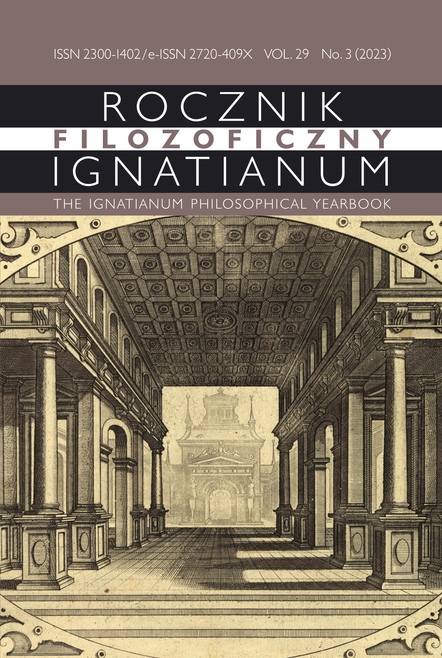Art as a Language Enriching homo oecumenicus in Creating Unity in Diversity
Abstract
The understanding of art in Christianity is not uniform. The churches approach this issue in different ways, explaining themselves by observing the second commandment of the Decalogue (Exodus 20:3-4). But what is important here is the approach to a given work of art, whether we look at it as an image of God, or rather as a window opened to transcendence. The encounter with art is based on three levels: the intention of the author, the intention of the work, and the intention of the recipient. In the richness of ecumenical diversity, art is like a symbol that has become a tool that enables access to God and to all reality that cannot be fully known by modern verbal language and human reason. Its main task is to lead the act of thinking of man through similarities to understand some things better and more fully than to recognize by the senses.
References
Balthasar von Urs Hans, Pisma wybrane. Pisma z zakresu sztuki i religii t. 2, przeł. Marek Urban, Danuta Jankowska (Kraków: Wydawnictwo WAM, 2007).
Bondaruk Konstanty, O nabożeństwie prawosławnym (Warszawa: Warszawska Metropolia Prawosławna, 2020).
Czernek Przemysław, „Protestancka architektura sakralna na Śląsku Cieszyńskim w XX i XXI wieku”, Rocznik Historii Sztuki 42 (2017): 193–230.
Durkheim Émile, Elementarne formy życia religijnego. System totemiczny w Australii, przeł. Anna Zadrożyńska (Warszawa: Wydawnictwo Naukowe PWN, 1990).
Dzidek Tadeusz, Funkcja sztuki w teologii (Kraków: Wydawnictwo WAM, 2013). Eco Umberto, „Pomiędzy autorem a tekstem”, w: Eco Umberto, Rorty Richard, Culler Jonathan, Brooke-Rose Christine, Interpretacja i nadinterpretacja, przeł Bieroń Tomasz (Kraków: ZNAK, 2008).
Evdokimov Paul, Poznanie Boga w Kościele Wschodnim, przeł. Alina Liduchowska (Kraków: Wydawnictwo M, 2000).
Evdokimov Paul, Sztuka ikony. Teologia piękna, przeł. Maria Żurowska (Warszawa: Wydawnictwo Księży Marianów MIC, 2006).
Gadamer Hans-Georg, Aktualność piękna. Sztuka jako gra, symbol i światło, przeł. Krzemieniowa Krystyna (Warszawa: Oficyna Naukowa, 1993).
Górna Małgorzata, „Hans Urs von Balthasar i jego rozważania muzyczno-teologiczne”, Pro Musica Sacra 13 (2015): 169–178.
Heidegger Martin, Bycie i czas, przeł. Bogdan Baran (Warszawa: Wydawnictwo Naukowe PWN, 1994).
Jan Paweł II, „List do artystów”, w: Jan Paweł II do artystów. Artyści do Jana Pawła II, red. Barbara Drożdż-Żytyńska, Magdalena Goławska, Piotr Kawałko, Agnieszka Oleszczuk, (Lublin: Gaudium, 2006), 30–57.
Jaskóła Piotr, „Protestantyzm w kulturze Śląska”, Roczniki Teologii Ekumenicznej, t. 3(58), 2011, 120.
Kopaliński Władysław, Słownik wyrazów obcych i zwrotów obcojęzycznych z almanachem (Warszawa: Wydawnictwo MUZA SA, 1980).
Księgi Wyznaniowe Kościoła Luterańskiego (Bielsko-Biała: Augustana, 2011). Łosski Władimir, Teologia mistyczna Kościoła wschodniego, przeł. Izabela Brzeska (Kraków: Wydawnictwo Uniwersytetu Jagiellońskiego, 2007).
Mikołaj z Kuzy, „De Non-aliud”, w: Philosophisch-theologische Schriften. Studienund Jubiläumsausgabe Lateinisch-Deutsch, Bd. 2 (Wien: Herder, 1996). Napiórkowski Stanisław, „Heidelberski Katechizm“, w: Encyklopedia Katolicka, t. 6, red. Jan Walkusz (Lublin: Towarzystwo Naukowe Katolickiego Uniwersytetu Lubelskiego, 1993), 631–632.
Palion Adam, „»Seminarium to też budynek«. Zarys historyczny powstania budynków Wyższego Śląskiego Seminarium Duchownego w Krakowie i w Katowicach”, w: Wyższe Śląskie Seminarium Duchowne 1924-2004, red. Józef Kupny (Katowice: Księgarnia św. Jacka, 2004), 139–174.
Popowski Remigiusz, Wielki słownik grecko-polski Nowego Testamentu (Warszawa: Oficyna Wydawnicza „Vocatio”, 1995).
Pseudo-Dionizy Areopagita, „Teologia mistyczna”, w: Pisma teologiczne, przeł. Maria Dzielska, t. 1 (Kraków: ZNAK, 1997).
Špidlik Tomáš, Modlitwa według tradycji chrześcijańskiego wschodu. Przewodnik systematyczny, przeł. Rodziewicz Lucyna (Kraków: Wydawnictwo OO. Franciszkanów Bratni Zew, 2006).
Szkiłądź Hipolit, Bik Stanisław, Pakosz Barbara, Szkiłądź Celina (red.), Słownik języka polskiego (Warszawa: Państwowe Wydawnictwo Naukowe, 1989).
Tischner Józef, Filozofia człowieka dla duszpasterzy i artystów (Kraków: Wydawnictwo Naukowe PAT, 1991).
Zdybicka Zofia Józefa, Religia i religioznawstwo (Lublin: Wydawnictwo Katolickiego Uniwersytetu Lubelskiego, 1992).
Copyright (c) 2023 Jesuit University Ignatianum in Krakow

This work is licensed under a Creative Commons Attribution-NoDerivatives 4.0 International License.
The Yearbook only accepts materials for publication that are free of all conflicts of interest, and that in no way involve conflicts over authorship, copyright, etc. The Editors will take action against any cases of plagiarizing, ghostwriting1, guest/honorary authorship2, etc. Where co-authored work is concerned, the Author listed first is expected to take responsibility for the submission, and is required to make clear the contributions of all of the Co-Authors involved. In the event of the publication owing its existence to funding dedicated to this purpose, this fact should be made clear: e.g. in any note of thanks/acknowledgement, or in a footnote, etc. Explicit notification should be given of any form of reprinting, with the appropriate evidence of permission to publish being furnished as required. Any impropriety on the part of Authors/Reviewers risks exposing them to appropriate responses from the relevant institutions.
______
1 This term refers to instances of a person who has made an essential contribution being omitted from the list of authors, or from notes conveying gratitude and/or acknowledgement.
2 This occurs when a person who has made either an insignificant contribution or no contribution at all nevertheless appears on the list of authors.





